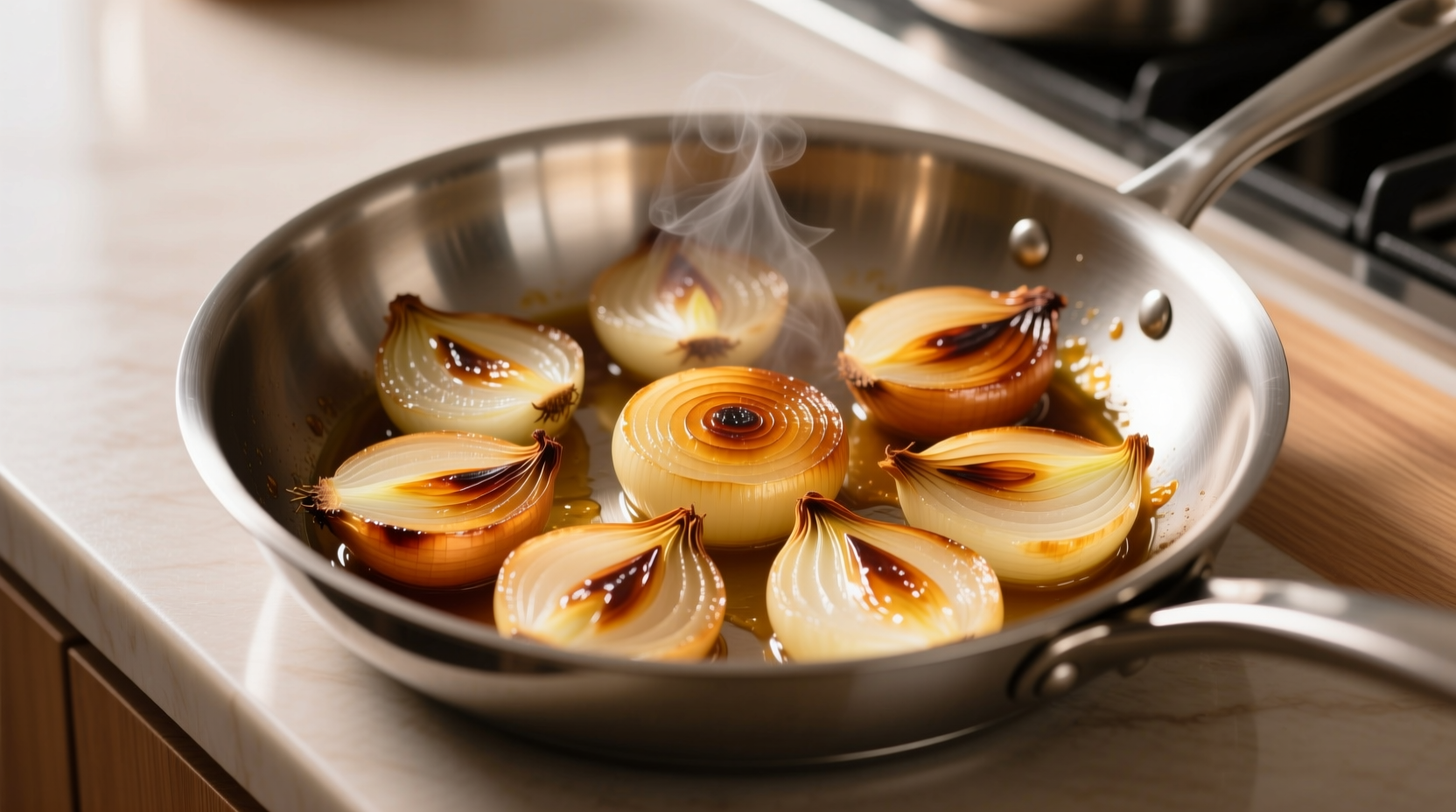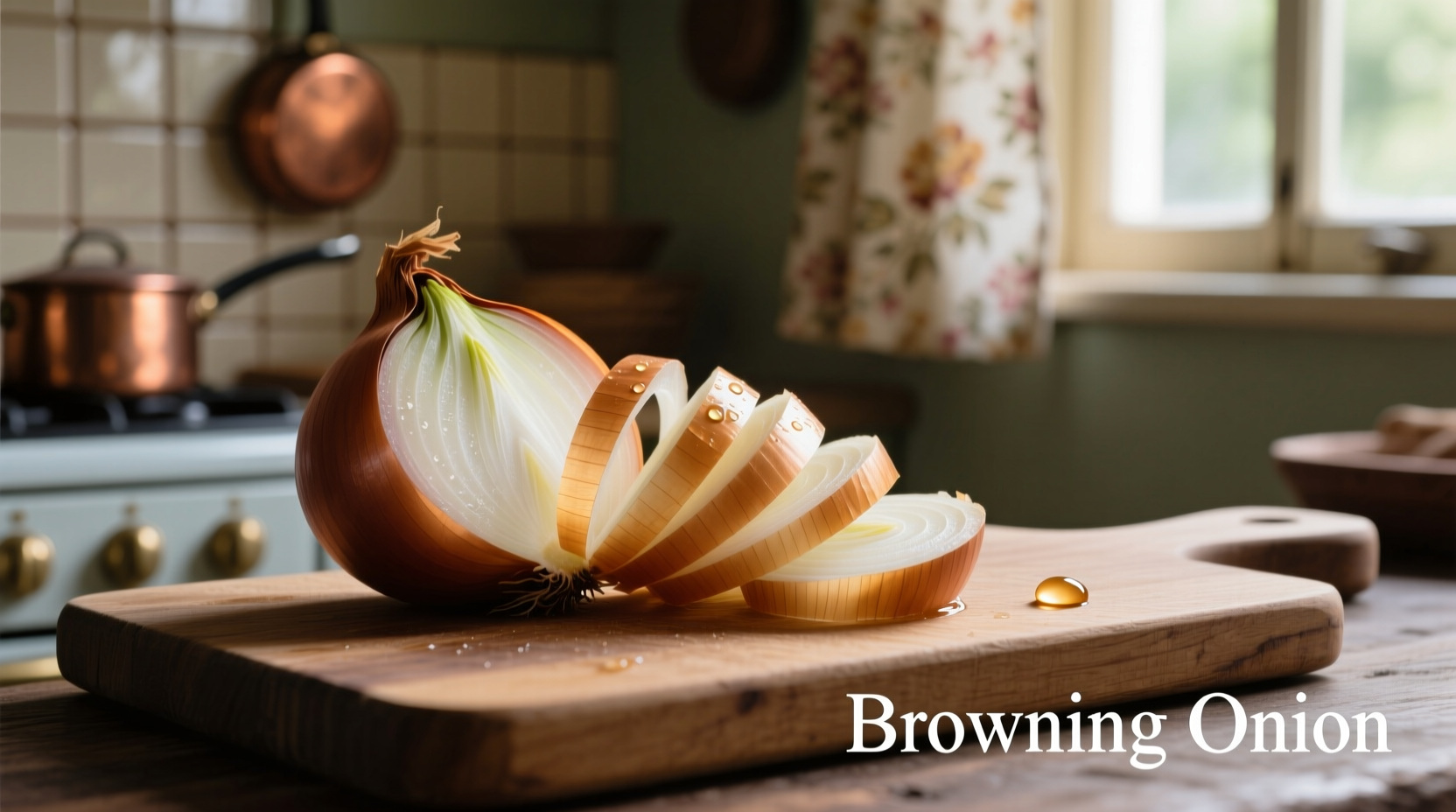The Science Behind Perfectly Browned Onions
Understanding the chemical reactions occurring when browning onions separates good results from exceptional ones. When onions hit your pan, two key processes begin simultaneously:
| Reaction Type | Temperature Range | Flavor Development | Visual Indicator |
|---|---|---|---|
| Maillard Reaction | 285-325°F (140-163°C) | Nutty, roasted complexity | Golden-brown color development |
| Caramelization | 320°F (160°C) | Sweet, buttery notes | Deep amber color, syrupy texture |
According to food science research from the USDA Food Safety and Inspection Service, both reactions occur during onion browning but require precise temperature control. Rushing the process with high heat triggers burning before proper flavor development occurs. The sweet spot for optimal flavor transformation sits between 275-300°F (135-150°C), allowing sugars and amino acids to react without scorching.

Preparation: Setting Yourself Up for Success
Professional chefs at the Culinary Institute of America emphasize that proper preparation determines 70% of your browning success. Follow these steps before heating your pan:
Onion Selection Guide
Not all onions behave the same when browned:
- Yellow onions (8-10% sugar content) - Ideal for deep browning and rich flavor development
- Red onions (slightly higher sugar) - Beautiful color but can become overly sweet
- White onions (lower sugar) - Best for quick sautéing rather than slow browning
- Shallots (highest sugar) - Caramelize fastest but burn easily
Cutting Technique Matters
Uniform 1/8-inch slices ensure even cooking. The America's Test Kitchen research shows that inconsistent sizing causes some pieces to burn while others remain raw. Always slice across the onion's equator (not pole-to-pole) for optimal structural integrity during long cooking.
The Browning Process: Step-by-Step Execution
Mastering the timing and temperature control transforms this simple technique into culinary magic. Here's the professional approach:
| Time | Visual Cue | Action Required | Flavor Development Stage |
|---|---|---|---|
| 0-5 minutes | Translucent edges | Stir occasionally | Moisture release begins |
| 5-15 minutes | Pale golden color | Stir every 2-3 minutes | Initial Maillard reaction |
| 15-25 minutes | Light golden brown | Stir every minute | Flavor compounds developing |
| 25-40 minutes | Rich amber color | Stir constantly | Peak flavor complexity |
Critical Temperature Management
Most home cooks fail by using too high heat. The perfect browning onion technique requires patience:
- Start with medium-low heat (not medium or high)
- Use enough oil to coat pan bottom but not submerge onions
- Never crowd the pan - cook in batches if necessary
- Add 1/4 teaspoon salt at beginning to draw out moisture
- Resist the urge to stir constantly during early stages
When executed properly, the entire browning process should take 25-40 minutes for yellow onions. Rushing with high heat creates bitter, burnt spots while leaving interior raw - the most common mistake home cooks make when attempting to brown onions quickly.
Practical Applications and Storage
Browned onions serve as flavor foundations across global cuisines. Professional chefs at Michelin-starred restaurants maintain batches for multiple applications:
Storage Methods That Preserve Flavor
According to National Center for Home Food Preservation guidelines, properly stored browned onions maintain quality for:
- Refrigeration: 5-7 days in airtight container
- Freezing: 3-4 months in portioned containers
- Oil preservation: 2-3 weeks refrigerated (not recommended for long storage)
Flavor Pairing Guide
Maximize your browned onions' potential with these professional pairings:
- Beef dishes - Add 1 tablespoon tomato paste during final browning stage
- Vegetarian applications - Deglaze with mushroom stock for umami boost
- Asian cuisine - Finish with 1/2 teaspoon soy sauce for depth
- Soups and stews - Add 1 crushed garlic clove in last 5 minutes
Troubleshooting Common Issues
Even experienced cooks encounter challenges when browning onions. Here's how to rescue common problems:
When Things Go Wrong
- Burning at edges - Immediately transfer to clean bowl, deglaze pan with water, reduce heat
- Excess moisture - Increase heat slightly and cook uncovered for 2-3 minutes
- Uneven color - Stir more frequently and ensure uniform slice thickness
- Bitter taste - Add 1/4 teaspoon baking soda to neutralize acidity
Remember that browning onions isn't just cooking - it's flavor chemistry in action. The time investment pays exponential dividends in dish quality. As culinary expert Harold McGee explains in On Food and Cooking, "The transformation of raw onion through careful browning creates more than 500 distinct flavor compounds that simply don't exist in the raw vegetable."
Advanced Browning Techniques
For those ready to elevate their onion browning skills, consider these professional methods:
- Double browning technique - Brown onions once, refrigerate overnight, then finish browning for intensified flavor
- Liquid augmentation - Add 2 tablespoons dry sherry when onions reach pale gold stage
- Layered seasoning - Add spices at different stages (cumin early, paprika late)
- Temperature cycling - Alternate between medium and medium-low heat for complex flavor development
Mastering the art of browning onions opens doors to professional-level cooking at home. This fundamental technique forms the flavor base for countless dishes across global cuisines, from French onion soup to Indian curries. The key lies in understanding that proper browning isn't just about color change - it's about carefully managing chemical reactions that transform simple ingredients into culinary magic.











 浙公网安备
33010002000092号
浙公网安备
33010002000092号 浙B2-20120091-4
浙B2-20120091-4